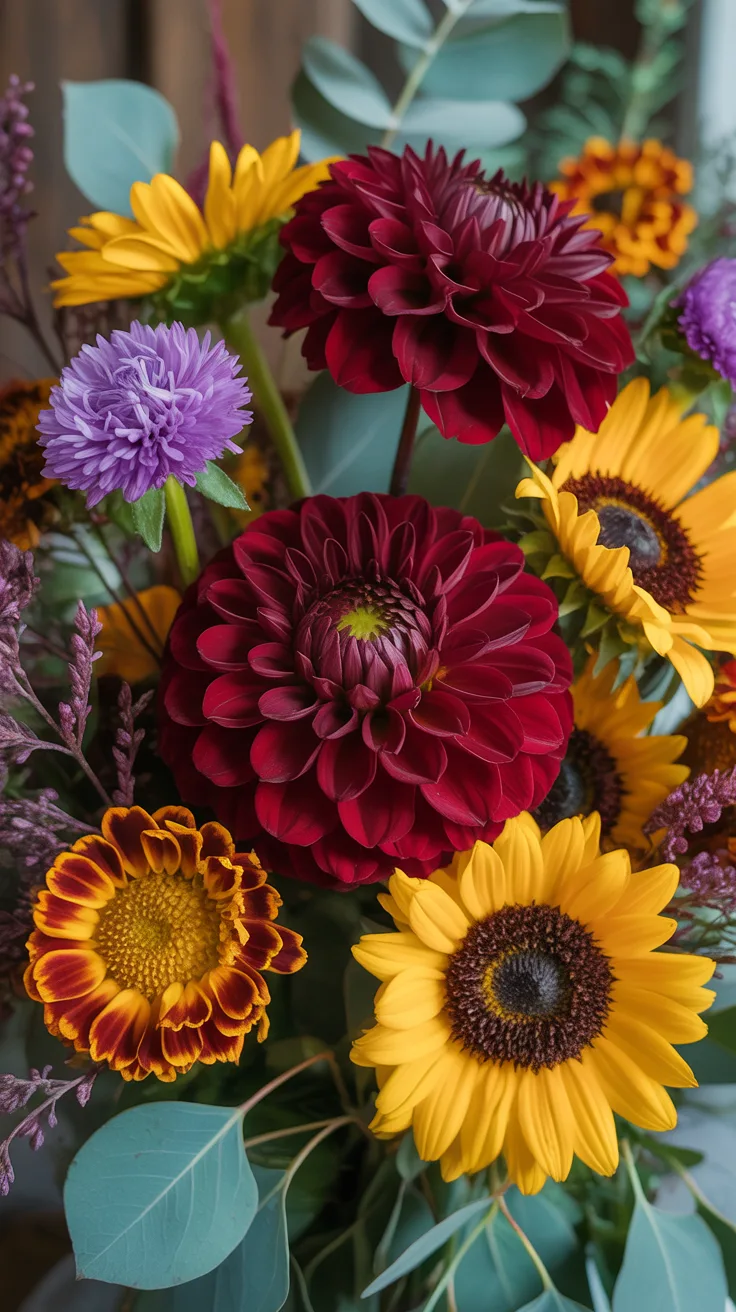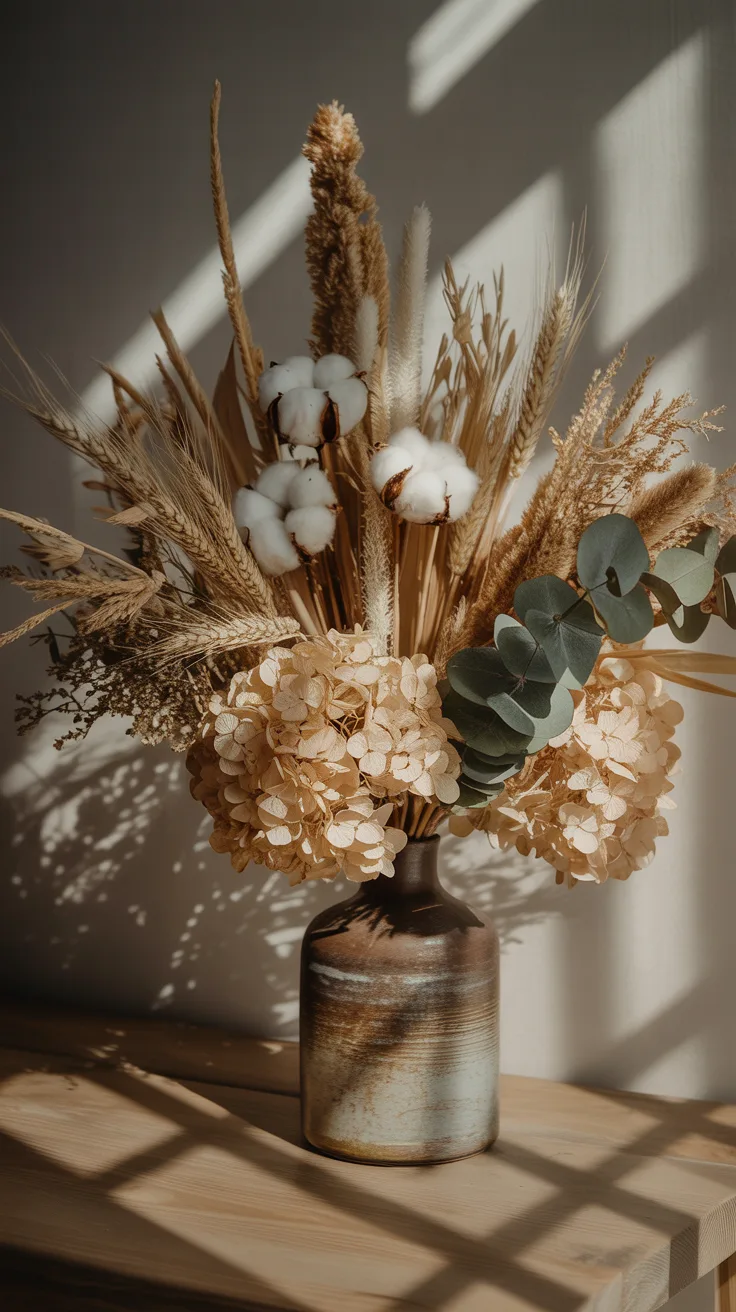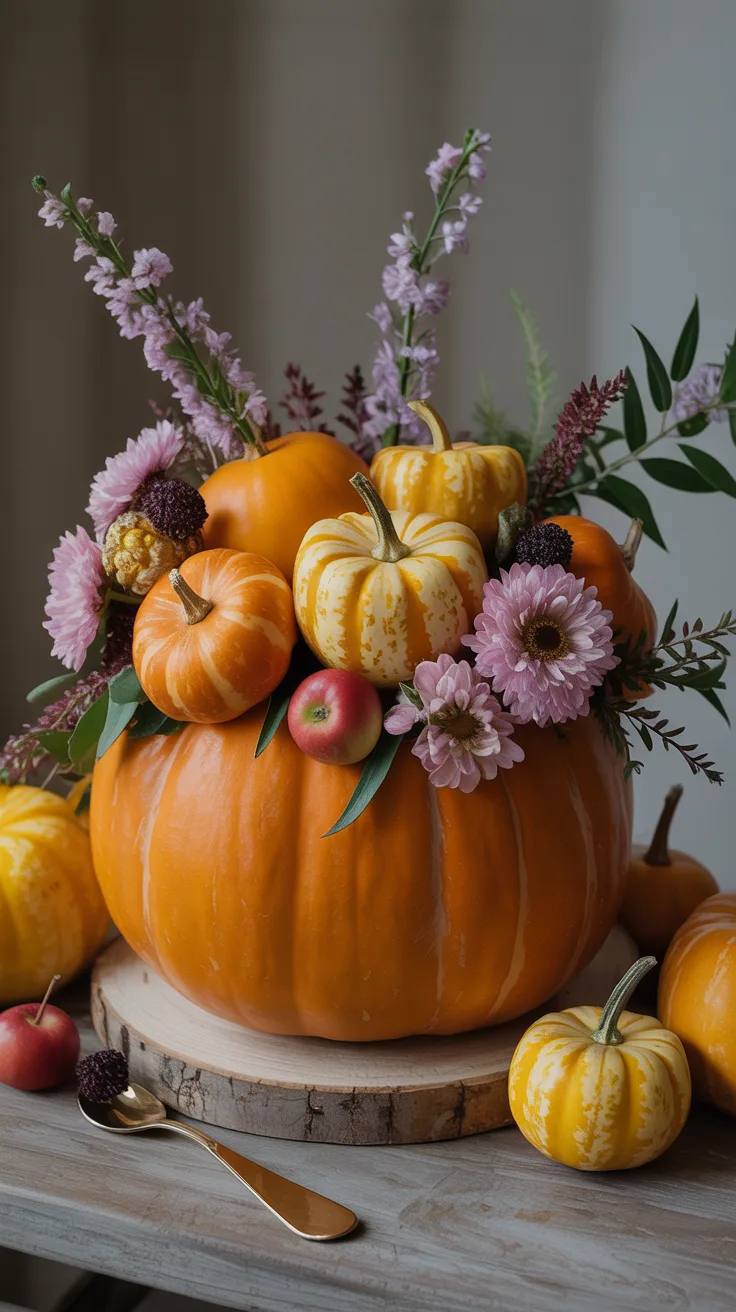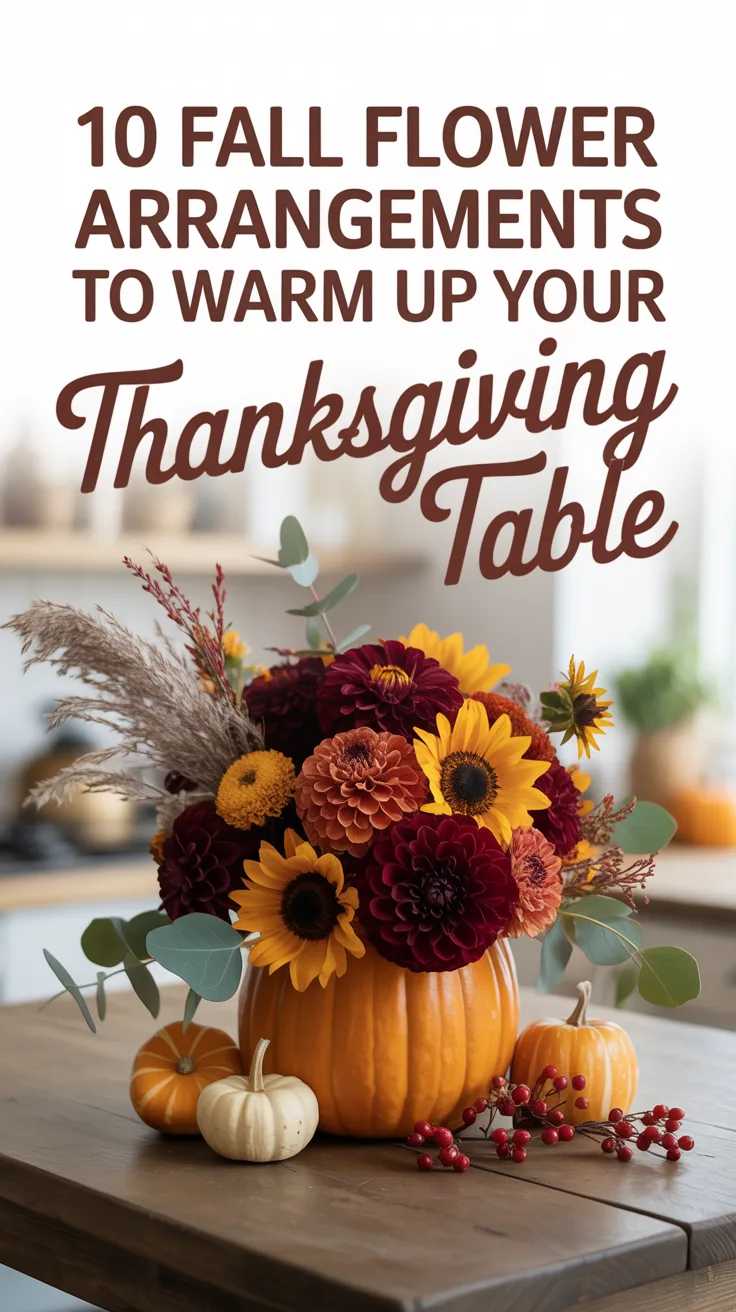
Introduction to Fall Flower Arrangements
When autumn arrives, I find myself drawn to the rich tapestry of colors that define the season. There’s something magical about bringing those warm hues indoors, especially when hosting Thanksgiving dinner. Over the years, I’ve discovered that fall flower arrangements can transform an ordinary table into a stunning focal point that captures the essence of the season.
I remember my first attempt at creating a Thanksgiving centerpiece—let’s just say my ambitious arrangement collapsed right as guests arrived! That disaster taught me the importance of proper technique and seasonal selection. Now, I’m excited to share my favorite arrangements that have consistently impressed my family and friends.
Whether you’re a seasoned decorator or trying your hand at floral design for the first time, these 10 fall flower arrangements will help you create a warm, inviting atmosphere that complements your Thanksgiving feast perfectly.
Classic Autumn Colors

The magic of fall arrangements lies in their rich, warm palette. I’ve found that embracing these seasonal hues creates an instant cozy atmosphere that guests respond to emotionally. When I first started creating fall flower arrangements, I made the mistake of including too many bright spring colors—a definite mismatch for the season!
The most effective autumn arrangements incorporate these classic colors:
- Deep burgundy: Dahlias and chrysanthemums in wine-red tones add depth and sophistication
- Burnt orange: Marigolds, zinnias, and certain roses capture the essence of changing leaves
- Golden yellow: Sunflowers and goldenrod bring warmth and brightness
- Rich purple: Asters and certain varieties of mums add an elegant contrast
- Forest green: Eucalyptus, ferns, and other foliage provide the perfect backdrop
Pro Tip: I’ve learned to limit my color palette to 3-4 complementary colors per arrangement. This creates a more cohesive, professional look than trying to incorporate every autumn shade at once.
My favorite combination is pairing burgundy dahlias with golden sunflowers and deep orange zinnias, accented with eucalyptus. The contrast between the dark and light elements creates visual interest while maintaining seasonal harmony.
Rustic Charm with Dried Flowers

I discovered the beauty of dried flowers by accident when I forgot about a bouquet in my garage for several weeks. What started as a mistake turned into my signature style! Dried elements add texture, longevity, and authentic autumn character to arrangements.
The best part? You can prepare these elements weeks in advance, taking pressure off your Thanksgiving prep schedule.
- Wheat stalks: Add height and a harvest feel
- Dried hydrangeas: Provide volume and a vintage appeal
- Pampas grass: Creates movement and soft texture
- Dried oak leaves: Incorporate authentic fall elements
- Preserved eucalyptus: Offers structure and subtle color
- Cotton bolls: Add unexpected texture and neutral tones
I love combining these dried elements with fresh flowers for contrast. My mother-in-law once commented that my arrangement looked “straight out of a magazine,” and I had to confess it was mostly composed of elements I’d dried from my garden months earlier!
Pro Tip: Spray dried elements lightly with unscented hairspray to prevent shedding and extend their life. I learned this trick after leaving a trail of wheat particles across my dining room during one memorable dinner party.
Incorporating Seasonal Fruits

One year, when my flower budget was particularly tight, I started incorporating fruits into my arrangements out of necessity. The result was so stunning that it’s now my favorite technique for creating truly unique Thanksgiving centerpieces.
Small pumpkins, gourds, and crabapples aren’t just decorative—they tell the story of harvest and abundance that’s central to the Thanksgiving tradition. I’ve found that these elements add visual weight and interest that flowers alone can’t achieve.
My go-to method involves hollowing out a medium-sized pumpkin to use as a natural vase. After sealing the inside with clear craft sealant (a step I painfully learned was necessary after a leaky disaster), I fill it with floral foam and arrange flowers directly inside. Surrounding the main arrangement with smaller gourds, persimmons, and clusters of berries completes the look.
Pro Tip: When incorporating fruits, remember they’ll decompose faster than flowers. Either choose hardier varieties like apples and pumpkins, or add them just before guests arrive. I’ve also used faux fruits successfully when I need the arrangement to last several days.
Modern Minimalist Arrangements
Not everyone loves the abundant, overflowing look of traditional fall decor. I discovered this when designing arrangements for my sister’s Thanksgiving—her modern aesthetic called for something more restrained and elegant.
For contemporary spaces, I’ve found that minimalist arrangements create stunning impact. The key is selecting a few perfect specimens rather than filling space with quantity. A single dramatic dahlia in a sleek vessel can be more striking than an elaborate mixed bouquet.
My favorite minimalist approach uses monochromatic color schemes—all burgundy or all golden yellow—in simple, architectural vessels. Clear glass cylinders, matte black ceramics, or brushed brass containers provide the perfect backdrop for this style.
I once created a row of three arrangements using just copper beech leaves in cylinder vases of graduating heights. The simplicity was breathtaking against a white tablecloth, and guests couldn’t stop commenting on the elegant effect.
Pro Tip: When creating minimalist arrangements, negative space is your friend. Allow each element room to breathe and be appreciated individually. I often remove elements one by one until the arrangement feels perfectly balanced—less truly is more in this style.
Pro Tips for Long-lasting Arrangements
Nothing’s more disappointing than creating a beautiful centerpiece only to have it wilt before dessert is served! Through years of trial and error (and some memorable failures), I’ve developed reliable techniques to extend the life of my arrangements.
The foundation of longevity begins with proper preparation. I always trim stems at a 45-degree angle under running water to maximize water absorption. This simple step can add days to your flowers’ freshness.
Temperature management is crucial—keep arrangements away from heat sources, direct sunlight, and fruit bowls (the ethylene gas from ripening fruit speeds flower deterioration). I learned this lesson the hard way when I placed an arrangement near a heating vent and returned to find it completely wilted in just hours.
For Thanksgiving specifically, I prepare my arrangements 1-2 days before, keeping them in a cool garage or basement until the event. This gives cut stems time to take up water and fully open to their prime state.
Pro Tip: Add a crushed aspirin or a capful of vodka to your vase water to inhibit bacterial growth. I’ve conducted side-by-side tests, and arrangements with these additives consistently last 2-3 days longer than those without.
If you’re creating arrangements in floral foam, soak it completely before arranging. Half-soaked foam will dry out quickly and can’t be re-wet effectively—a mistake I’ve made more than once that resulted in prematurely drooping flowers.
Conclusion
Creating beautiful fall flower arrangements for your Thanksgiving table doesn’t require professional training—just a willingness to experiment and learn from occasional mishaps (trust me, we all have them!). The arrangements you create become more than decorations; they’re expressions of the season’s abundance and your care for those gathered around your table.
I’ve found that guests remember the atmosphere of a gathering long after they forget what was served. A thoughtfully designed centerpiece sets the tone for the entire event, creating a sense of occasion that elevates the experience.
Whether you prefer lush traditional bouquets bursting with autumn colors, elegant dried arrangements with rustic charm, or sleek modern designs with minimalist appeal, the perfect Thanksgiving arrangement is the one that brings you joy and complements your personal style.
This year, I encourage you to try something new—incorporate an unexpected element, experiment with a different color palette, or simply take a moment to appreciate the beauty that seasonal flowers bring to your celebration. After all, Thanksgiving is about gratitude, and what better way to express it than by bringing nature’s beauty to your table?
Frequently Asked Questions
What flowers are best for fall arrangements?
The best flowers for fall arrangements include chrysanthemums, dahlias, marigolds, sunflowers, zinnias, and asters. These varieties naturally bloom in autumn colors and tend to have good longevity in arrangements. I particularly love using dahlias as focal flowers—their intricate petals and rich colors create instant impact.
How can I make my flower arrangements last longer?
To extend the life of your arrangements, change the water every 1-2 days, trim stems at an angle every time you change the water, keep arrangements away from heat sources and direct sunlight, and consider adding flower preservatives to the water. I’ve found that removing any foliage that falls below the waterline also significantly reduces bacterial growth and extends vase life.
What are some budget-friendly options for fall arrangements?
For budget-friendly arrangements, incorporate foraged elements like branches with colorful leaves, pinecones, and seed pods. Supplement with inexpensive flowers like chrysanthemums from grocery stores, and extend them with dried elements that can be collected and preserved weeks in advance. One of my most complimented arrangements cost less than $15 because I combined a few store-bought flowers with foraged elements from my neighborhood.
Can I create fall arrangements if I don’t have a garden?
Absolutely! While having a garden provides convenient access to materials, you can create stunning arrangements using flowers from farmers’ markets, grocery stores, or even foraged elements from public parks (where permitted). I lived in an apartment for years and created some of my most memorable arrangements using entirely purchased and foraged materials.
How tall should my centerpiece be?
The ideal height for a dining table centerpiece is one that doesn’t obstruct conversation—typically under 12 inches tall or above 20 inches tall. I learned this rule after creating a beautiful but frustrating arrangement that had guests constantly leaning around it to see each other! For Thanksgiving specifically, I prefer lower arrangements that allow for easy passing of dishes and unobstructed conversation.

